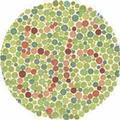|
Color Blindness Test Information
A color blindness test is a chart that's used to determine whether or not somebody has a deficiency in their ability to view colors. Color blindness is actually very common in modern society; so much so that it's estimated that between 10 and 20 percent of white males have at least some level of color vision deficiency. Color blindness happens when your eyes don't have the right amounts of cones in the retinas. Sometimes, you may have the normal amount but some of them don't do what they are supposed to. When light goes into your eye, it hits the cones in the main part of The Retina which is a membrane situated in the back of the eye. The specific function of these cones is to convert light wavelengths into chemical signals for the brain to process. Light travels in different wavelengths, and each color rides on a different wave. The main colors of the rainbow, red, orange, yellow, green, blue, indigo, and violet, are all separated by about 400 nanometers in wavelength. The cones in your eyes are genetically coded to be able to process different wavelengths like this. Therefore, you have cones that manage red waves, cones that manage blue waves, cones that manage green waves, and so on. If the genetic code is imprinted wrong there will be certain cones that don't do their job right. When the specific wavelength hits the right cone, that cone reacts and produces a pigment. If that cone isn't reacting to the wavelength the way it should be, it will either fail to react altogether or it will produce the wrong pigment. The most common way this happens is with the cones that produce red and green pigments, and when this happens you end up with a Red Green Color Blindness .
This type of Color Blindness accounts for nearly 99 percent of all the Causes of Color Blindness in the world. If this happens, your brain won't be able to distinguish red from green or vice versa. A color blindness test is the best way to see this in action. The gene that is responsible for Color Blindness is situated in the X sex chromosome. Males have an X and a Y chromosome while females have two Xs, so the color blindness trait appears as dominant in males much more often. For all the men who have color vision deficiency at some level, as much as 10 percent of the whole population, only about half of one percent of females actually show the trait. Sometimes the best color blindness test is simply looking at a rainbow. This is a combination of all the different wavelengths in the visual light spectrum. When light refracts off water in the air, the individual colors become visible; otherwise they are just seen as white light. If you have normal vision, you'll be able to identify all the unique colors of the rainbow. If you have a red Green Color Blindness though, you're more likely to see a series of greenish yellow stripes, possibly included with some light blues.

Subscribe to EyeSight Vision Care! , our monthly newsletter with in depth information to help you keep up to date on how to Protect Your Eyesight with a free bonus. Fill out the form below. You'll then receive an email asking you to confirm that you subscribed. You'll always have the option to unsubscribe at the click of your mouse.
|
More Information


















